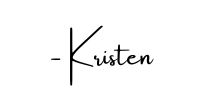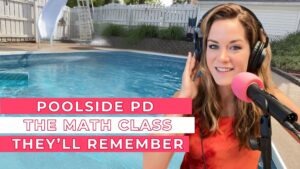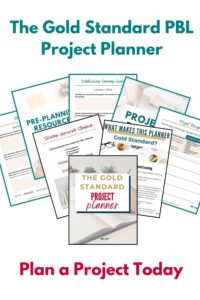How do you teach math with Project Based Learning?
A question I get most often is how on earth do we use Project Based Learning to teach math? After all, it is one of the most effective instructional strategies for math, but it can be challenging to start out!
Let me tell you, this is a GREAT question!
Project Based Learning encompasses all of the best mathematical practices that we want our students to develop: critical thinking, reasoning and sense making, and most obvious of all: problem solving! What is tricky for people to understand is how we can use project based learning to teach math content standards. And the truth is is real problems, get real results.
Project Based Learning in the Math Classroom
Launch your Project Based Learning Experience
A project begins with a launch that sparks the interest of the student. Many great project based learning ideas for mathematics can come from physics and finance, and thankfully both of those topics have great hooks to get the students interested…
“Did you say we get to make cannons Mrs. Moore?”
Why yes, yes I did. And you get to launch them over a pond and directly toward me.
Who wouldn’t be in, am I right? So clearly, the kids are hooked. It’s time to get them to start thinking about what they are going to need to know and do to be successful at the project. Here is where Student Generated Questions or Key Student Questions come into play. You can use a timeless approach like a “Know/Need to Know” protocol to gather these questions, but the key here is that we’ve got to make sure the student questions are driving our learning forward. You may have to help with question generation here, especially if this is a first time for you and your students!
Build Knowledge through Project Based Math
Now, as the teacher, it is up to you to determine what mathematical standards can be taught to answer those questions. You’ve got a variety of tools at your fingertips to craft lessons that meet the mathematical standards, but they will feel disjointed if you aren’t consciously connecting your lesson to the project. This is where you get to try your hand at creating/finding real and authentic problems for your students to tackle.
These aren’t your typical “Word problems” these are real WORLD problems. That’s where you’ll start to see the shift. Instead of arbitrarily determining the maximum height of an abstract object launched directly upward at a rate of…. UGH just stop. What is this object? Why do they care? Why is it being shot upward?! We’ve got to ask better questions to get better answers from our students. Let’s try that same concept again, but thinking about it in context of our project.
Project Based Learning Rewrite:
The distance across the millpond is 210 yards from the launch site to our target. Considering your projectile device, at what angle should you launch your projectile? And what maximum height will it be able to achieve?

THIS is going to get a much better reaction. You won’t believe how quickly kids will start building their projects so they can get outside and run simulations, collect data and then analyze that data to make changes. WHAT? Our kids are actually going to want to keep running calculations all day?
Well, yeah! I’m not going to lie, they’ll get tired of it, eventually… BUT they would rather work on this authentic real life math application than running through a skill and drill drill and kill worksheet. And the best part? The variables AND their coefficients are going to start to make sense. Contextualizing mathematics is SO POWERFUL. The students are going to gain a much deeper appreciation for the standard utilizing this method of practice. Through their trial and error, they are working to interpret. functions that arise in REAL applications in terms of the context of the project. What more could you want? Heck, you could even knockout all of F.IF.8 asking students to write and revise their function in different and equivalent forms to find you all the key information they need to know to have a successful launch of their project.
Critique & Revision in the Project Process
If it wasn’t clear already, students are going to be going through a lot of iterations to be able to come up with a successful launch. But just because it worked right once, doesn’t mean it is going to work again. Here you get to provide students with the opportunity to construct viable arguments and critique the reasoning of others (hey wait, isn’t that a Common Core Math practice?!) Each individual or group needs to have their work checked and validated by a classmate. Why? Because I am actually standing on the opposite side of that Pond, and I’ve already had one way too close for comfort confrontation with a potato cannon! And bam, look at that, students are finding more authentic ways to work on their procedural skills.
Want to really kick it up here? Have them analyze functions using different representations to verify the work. Have you tried using the Rule of 4 with students? A great way for students to verify their conceptual understanding connecting graphical, numerical, algebraic and written expressions of the same content. Try it, and see how much better your students start understanding functions on a conceptual level.
Present and Reflect on the Project Based Experience
Well, they’ve done it. You have all made it to launching day. And thankfully, your students have seen plenty of project examples throughout the process as they’ve worked with their classmates to revise both their projectiles and their calculations. You can confidently head out to the pond for your big launch to present the work they’ve done for the past few weeks. Have your students share out how they calculated the right trajectory path for their project before launching, and then let the fun begin. When it’s all over, talk about what went well, and what happened to those rockets, tennis balls, and pumpkins that didn’t make it all the way over. What could have gone wrong? After all, our math was correct, we’d successfully solved for x. How could this have happened? Looks like there’s Moore to math than just Solving for X afterall….
Thanks for going with me on this trip back down memory lane!
For more project based learning math examples, I recommend checking out the following sites:
You can also read up on more things project based math (and grab some freebie downloads!) if you check out these articles on my site:
- 7 Steps to Project Based Learning
- Quadrilateral Project Overhaul: from Project to Project Based Learning <–A great one for Geometry teachers!
Or if you are feeling skeptical check out Why Not To Use Project Based Learning to Teach Math

Ready to take the plunge yourself?! Join us in the KickAss Math Class Kickstart Challenge where you will create your own PBL experience in just 5 simple days! It’s my signature 5 day challenge, and it is completely free to you!
You’ve heard how I do it, now let me help YOU use Project Based Learning to teach Math!

- Want my help designing a project to engage your students? Visit Work with Me to sign up for coaching!
- Thinking you want me to design a lot of projects for you? I’m opening up a membership program where I’ll be providing Common Core Math Standards aligned projects designed to work with nearly any curriculum to you monthly. Visit Work with Me to get on the wait list and find out more about when that membership opens!
Remember, math gets a little more fun (and a little more real) every time you take a modern approach.
I’ll see you next time.











2 Responses